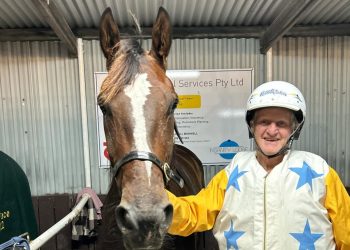I really love the standardbred horse…and I mean ALL harness racing standardbred horses.
Our equine athletes race their hearts every single stride of their journey and are honored and cherished and etched in our history with winner’s circle photos and daily care with feed and baths and leg massages and wraps and new shoes and loving…that is, until they are no longer of use as a money-making vehicle for the trainer and owner.
 Malnutrition and lack of care await many of them with, tragically, a kill pen even awaiting some.
Malnutrition and lack of care await many of them with, tragically, a kill pen even awaiting some.
That is a sin.
So, here’s an idea.
Here in the United States the full retirement age for Social Security is 67, but one may apply as early as age 62.
It’s a blessing for millions.
Recipients build up “points” while in the workforce over the years, with 40 points needed to become fully insured.
Our breed deserves the same entitlements after retiring from the wars of racing.
Full retirement age for the “working” standardbred racehorse is, generally, 15 and a “social security” program for our four-legged family members is long overdue.
“Can’t be done,” you say?
Our Social Security Act was signed into law without a dime in 1935, creating a social insurance program designed to pay retired workers a continuing income.
It had to start somewhere, didn’t it?
How about NOW for our four-footed family members.
An equine social security program could feature a full retirement benefit when aged 15 with early applicants eligible at, say, 12.
The pay scale could be a blend of seasons raced and number of starts with a graduating point system—just like in the U.S.—determining benefits.
In the U.S., Social Security is funded through a dedicated payroll tax.
The Equine Social Security Tax (ESST) could be funded with a 1/2 of 1% tax on purses which, last year, were $483,775,811 meaning the ESST would be funded to the tune of $2,418,879.06 for that particular year.

That’s not a lot of money but, on the other hand, there are not a lot of 12-year-olds that race these days.
Does it really matter if a $24,000 purse is $23,880 with the winner getting $11,940, or $60 less?
Does it really matter if a $3,800 purse is $3,781 with the winner getting $9.50 less?
All horses bred in the United States would be eligible for Equine Social Security with any foreign bred horse eligible by building up “points” based on seasons raced and number of starts.
Since the program would be eligible for 12-year-olds and up, the ESST buildup could be substantial in a few years—just like the U.S. Social Security program which began in 1935.
Younger horses and stakes horses probably wouldn’t be eligible as they wouldn’t build up enough points to qualify BUT there may be a disability clause added to address that situation.
The percentage of 12-year-olds and up racing is extremely low, so the program would not be in any danger of going “bankrupt,” which is threatening the U.S. system, largely because the members of Congress “borrowed” from it and never paid it back!
This program would make such a difference in the lives of our aging equine athletes and substantially cut the very thought of even thinking about a kill pen.
Benefits could be used for feed, showing and general health care with owners knowing that the costs after racing days are over would not fall on their shoulders.
Owners who decide to keep their retired standardbred would receive benefits to defray costs and there are many organizations that could benefit, as well.
A “grants” program could be established whereby the many organizations that survive on donations and look after and care for the retired standardbred could apply for funds to continue their work—similar to our college grants for students.
Not only that, but many of these organizations are also therapeutic in nature helping “children of all ages” that have suffered traumatic experiences in life.
The Standardbred Retirement Foundation, Volunteer Equine Advocates, Tomorrow’s Rainbow, Hopes Dreams and Horses, Vinceremos Therapeutic Riding Center, Bit-By-Bit and Steele Magnolia Sanctuary are just a few of the charitable organizations that could continue their vastly important work in this field.
How important is this matter?
The Standardbred Retirement Foundation over the past couple of years alone, saved over 1,500 tagged for slaughter.
Volunteer Equine Advocates was founded to help abandoned, abused and neglected horses and their number of rescues is over 1,200. Their motto of “Rescue, Rehab and Rehome” has proven very successful during their 20 year history.
Tomorrow’s Rainbow plays an important part in the lives of children, teens and families by incorporating horse interactions with therapeutic play.
Hopes, Dreams and Horses is a therapeutic center for children and adults improving lives through therapy and interaction.
Vinceremos Therapeutic Riding Center serves people with physical, cognitive and emotional disabilities using rescued horses as the catalyst for improving lives.
Bit-By-Bit, founded in 2002, specializes in hippo-therapy, referring to occupational therapy, physical therapy and speech therapy. They also offer an Adaptive Riding Program called Horses for Heroes—a free-of-charge program to U.S. Veterans with disabilities.
Steele Magnolia Sanctuary provides permanent refuse for abused and neglected horses and, once they are restored to health, the horses, themselves, become healers to children and adults through therapeutic equine assisted activities.
It’s time to REALLY say thanks to those horses…those veterans…those war horses that help fill racing cards week-after-week…and year-after-year.
by John Berry, for Harnesslink

 USA
USA Canada
Canada Australia
Australia New Zealand
New Zealand Europe
Europe UK / IRE
UK / IRE



